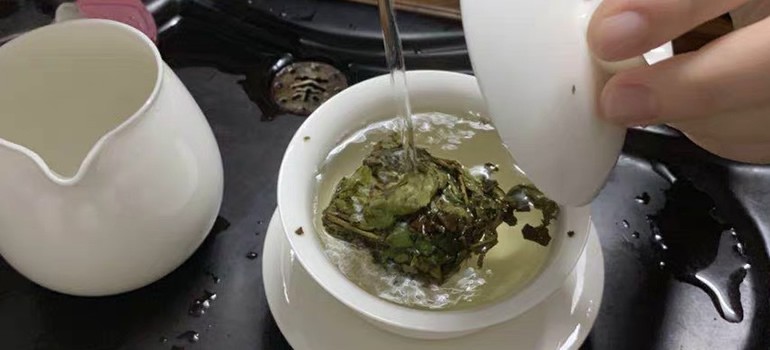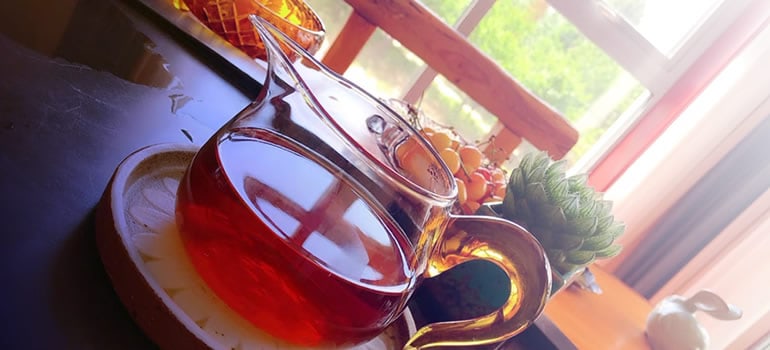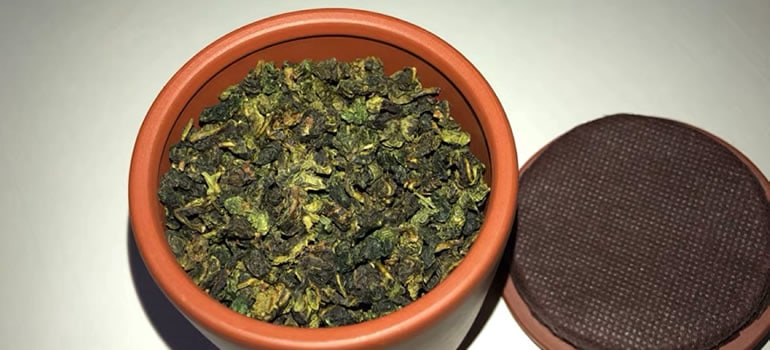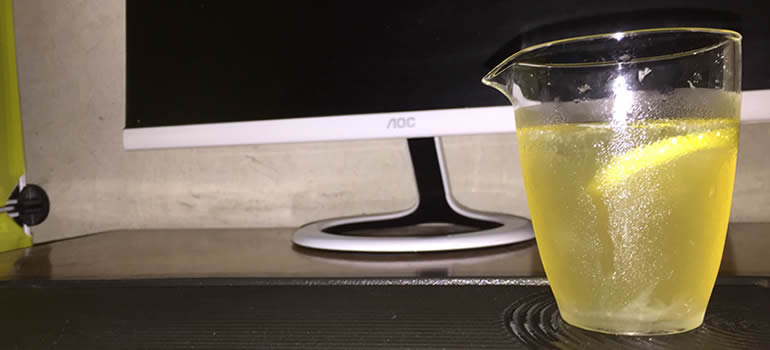Tea comes in many different shapes and forms.
And let’s not forget colors!
Interestingly enough, some people are able to easily recognize the different types of tea just by taking a good look at its color.
But let’s take a step back. According to the statistics, the most popular types of tea that Americans drink are:
- Black tea (84%);
- Green tea (15%); and
- Oolong, white and dark tea (1%).
But did you know that all of these despite having a different color – and a different name, for that matter – are derived from the same plant?
‘Okay, what is going on?’ you may ask. ‘Why do they have different colors then?’
Here’s the thing.
As it seems there is something very special and unique that is making them different in shape, color, quality, and flavor.
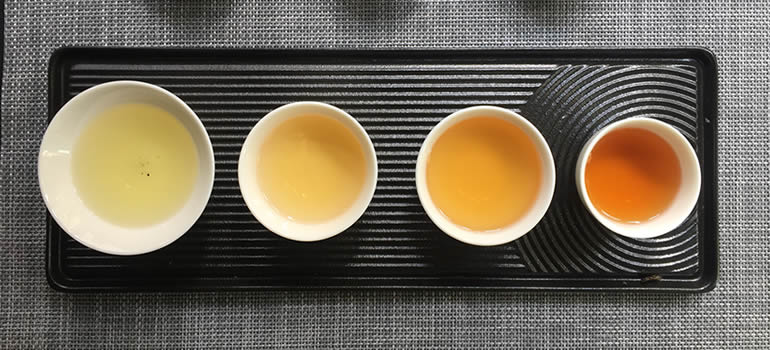
Does the Color of Your Tea Matter?
In fact, the color of your cup of tea can tell you a lot about its properties, quality, and even content.
But why do the different types of tea have different colors? Does that have anything to do with its quality and health benefits? The answer to those questions is going to be, yes.
Tea is usually made from the leaves of the Camellia sinensis plant. These are considered “true” teas and what separates them is the processing methods that manufacturers use, cultivation methods, variety, and more.
Since we are talking color. We will begin with the lightest tea and end with the darkest one.
White Tea
White tea, in general, goes through very little processing.
- After picking the leaves, they are left to wither. Usually, this is done by leaving the tea leaves out in the sun or indoors.
- Sometimes they may go through some light baking or rolling.
- After the tea leaves wither, then they go through a process of drying.
What makes white tea unique is that farmers usually select and pick only the youngest buds and leaves for its preparation. The reason why it is called white is that the young leaves and buds used for its manufacturing are covered with fine white hairs.
The tea leaves go through very little to no oxidation, and they are not fermented at all.
Taste and Color
After brewing and steeping your tea, you will be left with a very light and pale yellow colored tea.
White tea has sweeter, significantly lighter, more delicate, and mild taste compared to the other types of tea on this list. White tea usually has a slightly sweet taste to it.
Caffeine Content
You will find out that all teas made from the Camellia sinensis leaves do contain caffeine.
But thanks to the little processing, white tea actually contains very low amounts of caffeine. This may be good news for many.
The actual amount of how much caffeine white tea contains will depend on various factors. The processing methods used, the variety of the tea, the amount of tea leaves or tea bags used, steeping time, and even the water temperature can ultimately have a say in that.
Generally speaking, on average, a standard cup of white tea may contain anywhere from 15 to 20 mg of caffeine.
Brewing and Steeping
The longer you steep the white tea, the more antioxidant-rich it will be. The steeping temperature doesn’t affect it that much so you can steep it at 170 to 180 F for about 3-6 minutes for best results.
The amount of tea you use should be about 1.5 to 2 teaspoons for a regular 8-oz cup of water.
Of course, depending on your personal taste and liking, you may want to experiment with these numbers in order to find out what works best for you. Also, if your tea came with specific instructions, you can follow them first.
Benefits of White Tea
- High Antioxidant content – White tea is a rich source of healthy antioxidants, and the longer you steep it, the more of them will end up being in your cup of tea.
- Provides energy and focus boost.
- Improves oral health – White tea contains catechins, tannins, and fluoride. All three of these play a key role in making your teeth stronger and healthier. They can not only protect your teeth against dental cavities but also from the forming of plaque bacteria.
- It is good for the brain.
- Promotes weight loss – White tea contains caffeine and other chemical compounds that have been proven to have fat-burning properties. Studies have shown that white tea can increase your metabolism slightly.
- It reduces LDL cholesterol, also known as the “bad” cholesterol.
- Healthier heart – Tea has been proven to lower the chances of suffering from heart disease.
- It has anti-cancer properties.
- It can also improve skin health.
- Good for the bones.
- May protect against Parkinson’s and Alzheimer’s disease.
Yellow Tea
A rare and more expensive tea, yellow tea may be one of the more obscure types of tea, but this doesn’t mean it is not worth drinking it.
Yellow tea’s processing methods are very similar to those used in the preparation of green tea.
However, yellow tea goes through a moist heating process or steaming, also known as yellowing. This process is what separates the yellow tea from the rest as it allows it, briefly and very lightly, to oxidize.
Taste and Color
The light oxidation it goes through gives its very mild, delicate, and mellow taste. Unlike green and black tea, yellow tea has a much more delicate flavor and lacks the subtle grassy aroma of green tea.
The color of yellow tea is, as you may have guessed, a distinct light or pale yellow.
Caffeine Content
Yellow tea is made from the same plant white, green, and black tea is made of. So naturally, it too contains caffeine.
The amount of caffeine you may expect a regular 8-oz cup of yellow tea to contain is roughly going to be about 33 mg. That places it between white and green tea.
Steeping Temperature and Time
Yellow tea is more delicate, so it is recommended to use water with temperatures between 167 to 176 F and steep it roughly for 3 minutes.
If you are using loose leaf tea, you can use about one teaspoon per 8-oz cup of water.
If your tea came with instructions, use them, and adapt accordingly to your personal preferences. You may want to experiment with the steeping time and tea amount.
Benefits
- Yellow tea is a rich source of polyphenols, which have a positive impact on the cardiovascular health.
- It also has anti-inflammatory, anti-aging, and anti-cancer properties
- Yellow tea extract has been connected with reduced hunger levels which may play an important role in boosting weight loss.
- The polyphenols can aid people who have type 2 diabetes.
- It may help in treating non-alcoholic fatty liver disease.
- Polyphenols may have a positive effect on various digestive issues as well.
Green Tea
Green tea is the most popular and widely consumed type of tea in the East. Of all the tea types consumed worldwide, 20% is green. However, during the last couple of years, we’ve seen it gaining more popularity in the United States.
Green tea is made from the Camellia sinensis tea leaves.
After being harvested green tea goes through a heat-processing – either steaming or panning – which prevents any oxidation of the leaves. The next step in their processing is rolling and lastly drying.
Taste and Color
The color of green tea can vary from pale yellow to light green or even light brown. The actual color will depend on a number of factors among which are brewing time, tea variety, processing methods, and more.
The taste of green tea can vary as well.
Again – just like with any other kind of tea – the actual taste and subtle flavors will be affected by where and how the tea has been grown, processing techniques, methods of harvesting, and more.
The taste green tea has will range from relatively mild grass-reminiscent, vegetal and floral, to sweet, or bittersweet, nutty and even lightly astringent.
Caffeine Content
The same plant is used in the preparation of green tea, and we can safely assume that there will be some caffeine content in our cup of green tea too.
But how much?
There is roughly 20 to 35 mg of caffeine in a standard 8-oz cup of green tea.
If you are interested in taking advantage of the numerous health benefits green tea consumption provides, but want to avoid upping your caffeine intake, decaf green tea is an ideal option with its roughly 2 mg of caffeine per cup.
Interestingly enough – for the caffeine-conscious – opting for loose leaf tea as opposed to tea bags would be beneficial. Usually, a more finely cut and broken down tea leaves tend to release a higher amount of caffeine.
Steeping Temperature and Time
The rule of thumb for green tea is that it should be steeped at lower temperatures – 140 to 185 F.
Green tea should be steeped for 1 to 3 minutes, depending on individual preference and taste. With different varieties of green tea, you may need to experiment as small adjustments to the steeping time may be required.
Also the cooler the water temperature the longer you would generally need to steep green tea for.
One study showed that the longer the steeping and the lower the temperature-time, the higher the antioxidant content.
Additionally, the hotter the water and the longer the steeping time of green tea, the higher amounts of caffeine will be extracted.
An interesting fact, perhaps, is that one study discovered adding soy or dairy milk to your green tea will reduce the antioxidant availability of the tea.
Benefits
- Green tea is a rich source of natural antioxidants and some minerals. All of these are well known for their positive effect on the body, including, lowering inflammation, anti-cancer properties, preventing damage to the cells, reducing the free radicals, and treat diseases.
- The caffeine content in green tea can improve brain function, mood, and even memory.
- Green tea contains the amino acid known as L-theanine, which can lower anxiety and increase dopamine.
- Green tea promotes an increase in metabolic rates, which means it has weight-loss and fat-burning capabilities, although the effects of said metabolic increase vary significantly from person to person.
- It may be able to protect against Alzheimer’s and Parkinson’s.
- The catechins found in green tea can promote better dental hygiene and health.
- Green tea has shown to lower cholesterol levels.
- Studies suggest that green tea can reduce blood sugar levels and improve insulin sensitivity.
Oolong Tea
Oolong is a popular type of tea used in China and Taiwan. On a global scale, however, it is not as widely used as it accounts for not more than 1 or 2 percent of total tea consumption.
Oolong tea, just like green and black tea – comes from the same plant – the Camellia sinensis plant.
What separates it is the partial oxidation it goes through.
This places it somewhere between green and black tea in terms of oxidation percentage.
Then again, this is not that simple.
Partial oxidation may mean a lot of different things. The amount of oxidation can vary greatly; in fact, it can range anywhere from 8 to 80 percent.
Taste and Color
As a result of the varying degrees of oxidation, the taste of your oolong tea may vary greatly, too. If it has been less oxidized, it may resemble green tea, and if it has been more oxidized, it may be more reminiscent of how black tea tastes.
In addition to that, oolong tea is also subjected to rolling or ball shaping. And the actual methods used in this process can again affect its color and taste.
The taste can be anywhere from very light to very strong. From grassy to nutty. And from sweet to astringent.
And the color of oolong tea can vary significantly from very light green to amber and light brown.
All this can make oolong tea a box full of surprises.
Caffeine Content
Oolong’s caffeine content is usually similar to that of green tea, but generally not as high as black tea.
Oolong contains about 45 mg of caffeine per standard 8-oz cup of tea.
Brewing and Steeping
The usual water temperature used for steeping the oolong tea is about 180 to 205 F.
Use 2 to 4 grams of oolong loose leaf tea per standard 8-oz cup of water.
If your oolong tea came with specific instructions and recommendations, follow them, and adjust according to your personal taste and preferences.
Benefits
- Oolong tea has been associated with reduced levels of “bad” cholesterol, triglycerides, and total cholesterol.
- Oolong tea contains fluoride, which can reduce the risks of developing cavities.
- It can lower the risks of developing type 2 diabetes.
- There are a few studies suggesting oolong tea can stimulate weight loss.
- Oolong tea consumption can lead to lower risks of developing heart disease.
- It may also have anti-cancer properties.
Red Tea
When mentioning red tea, we may be referring to, generally, three types of tea, black tea, rooibos tea – both of which we will come to in a bit – and hibiscus tea.
Hibiscus tea (also known as Karkade) has been used for hundreds of years for its refreshing and healing properties.
It has been especially popular in ancient Egypt where Pharaohs would drink it to stay refreshed and hydrated.
Taste and Color
Hibiscus tea is an herbal tea with a very unique exotic, strong, and flavorful taste. Frequently a great many people add a little bit of honey or sugar to their hibiscus tea in order to bring down its bitterness.
Adding lemon to it is also a viable option which will accentuate its strong and exotic flavors.
Both black and rooibos tea have a slightly reddish hue, while hibiscus usually can be as red as a tea can get.
Caffeine Content
Hibiscus tea is made from the Hibiscus sabdariffa flower, and it is considered a tisane or herbal tea. Unlike the “true” tea types, it doesn’t contain any caffeine.
So, as a result, you can enjoy a nice cup of hibiscus tea before going to bed without having to worry about disturbing the quality of your sleep.
Brewing and Steeping
Use about 1 to 2 teaspoons of hibiscus tea per standard 8-oz cup of water. It is recommended to use water that has been brought to boiling at temperatures of about 200 to 212 F.
Hibiscus tea lends itself to longer steeping. You can generally steep it for 3 to 7 minutes.
If your hibiscus tea came with specific instructions for brewing and steeping make sure to follow them.
Benefits
- Hibiscus tea is mostly used for its ability to lower blood pressure. However, make sure to speak with your doctor first if you intend to drink it for medicinal purposes.
- Several studies suggest that hibiscus tea can promote weight loss.
- Hibiscus has a high content of various antioxidants, that can negate the adverse effects of free radicals.
- Hibiscus tea may improve liver health.
- Although studies on the subject showed mixed results, hibiscus may have a positive effect on lowering cholesterol and triglyceride levels.
- Hibiscus tea contains high amounts of polyphenols which are known to have a number of positive effects on the body, including anti-cancer properties.
Rooibos Tea
You may be pleasantly surprised to find out rooibos tea is not considered a ‘true‘ tea, because it is not made from the Camellia sinensis plant.
Rooibos is an herbal tea, and unlike the green, black, or white tea, which are typically grown in China, it is grown mostly in South Africa.
Rooibos tea leaves go through an oxidation process. Green rooibos tea which isn’t oxidized – although more expensive – is also available.
Taste and Color
The typical color of rooibos tea is light red. This is not a surprise considering its name means ‘red bush.‘
Unlike black or green tea, rooibos has a more subtle and mild taste. Its flavor is sweet, and it has a delicate nutty and earthy taste. While on the other hand, green rooibos tastes more malty and grassy.
With teas made from the Camellia sinensis plant, the longer you brew or steep them, the more bitter they tend to get.
This is not the case with rooibos tea, however. The reason behind that is the low level of tannins it contains.
Caffeine Content
All teas – the ones considered ‘real‘ teas – made from the Camellia sinensis plant will contain caffeine.
But rooibos is a different plant. And it doesn’t contain any caffeine.
Brewing and Steeping
For steeping use water with temperatures between 200 to 212 F.
You can steep the tea for longer, usually about 5 to 6 minutes according to personal taste. The longer you steep rooibos tea, the more nutrient-rich will be your cup of tea. So even if you decide on steeping it for, say, 15 minutes, it will still taste very good. Longer steeping time will not make it bitter. However, it may get cold.
If you are using loose leaf tea, you can try to use about a teaspoon and a half per 8-oz cup of water.
Benefits
- Although the studies show mixed results, scientists agree that rooibos has a high amount of certain antioxidants that may potentially have a positive impact on the body.
- It is perfectly suitable for people that are sensitive to caffeine, or people that have to lower their caffeine content.
- It is very low in tannins, which are known to reduce the absorption of iron.
- Rooibos may potentially help you with losing weight. It can increase the levels of leptin, which is a hormone known to regulate satiety.
- Drinking rooibos tea has been shown to lower LDL (bad) cholesterol levels while increasing HDL (good) cholesterol levels.
Black Tea
Black tea may easily be considered the most popular type of tea. It is made from the same plant as the majority of the other teas on this list – the Camellia sinensis.
In order to be considered black, the tea leaves have to go through a long journey. They go through the highest amount of oxidation, unlike the white, green, or even oolong teas.
There are also two main processing methods used:
- The Orthodox Method; and
- The Cut, Tear, Curl Method.
Taste and Color
The tea leaves are fully oxidized before being dried and heat-treated. This oxidation is responsible for the deep brown color black tea is so famous for. Depending on how long it has been oxidized for the color may range from amber to deep red as well.
The oxidation process is responsible and for one more thing: its taste.
Because black tea is fully oxidized, this gives it a stronger flavor. Black tea usually has a flavorful, astringent, and bitter taste, but it can also be sweet depending on the processing methods used.
Because black tea has such a strong and astringent taste, it can be used with some milk or sugar (just like a cup of coffee).
With that being said, plain black tea still remains the best way to truly experience and enjoy it. Because black tea has different flavors, you will be able to catch on the subtle changes of flavor that way.
However, not all black tea is created equal, and the taste can vary between the different black teas. The taste depends on many various factors like:
- How much oxidation it went through;
- The type of processing it went through;
- The packaging methods used;
- Where and how it was grown;
- Types of fertilizers and chemicals used in the growing process; and
- Nearby crops, plants, and overall environment.
Caffeine Content
Black tea generally has more caffeine content than the rest of the teas made from the Camellia sinensis plant.
Despite that fact, black tea cannot really compare to the caffeine content of a regular cup of coffee. Black tea usually has about half the caffeine content of a cup of coffee.
A standard 8 oz cup of black tea typically contains about 47 mg of caffeine.
And for those of you that want to enjoy a warm cup of tea while cutting down on your caffeine intake decaf black tea is still an option which typically contains about 2-3 mg of caffeine.
Brewing and Steeping
The general recommendation for a regular 8 oz cup of water is to use 2 mg of black tea and steep them at 200 to 212 F, for about 2 to 5 minutes. However, if some specific steps and details came with your tea, you can use them, too.
Black tea is best steeped for a shorter amount of time – typically about 2 to 3 minutes. The reasons for that are two:
- Black tea has a very strong taste. The longer you steep it for, the more bitter it will get.
- The longer you steep black tea, the lower the antioxidant content becomes.
Steeping the same tea multiple times is generally not going to produce as quality and flavorful cup of tea as the first steeping. But the high-quality black loose leaf tea lends itself quite nicely to being re-steeped multiple times.
Benefits
- Black tea has high amounts of caffeine, making it a very good pick-me-up beverage to give you a little extra energy boost.
- Black tea can have a positive impact on your levels of alertness and focus thanks to the caffeine and L-theanine content it has.
- It is also a rich source of antioxidants that lower the risk of developing chronic diseases by reducing the free radicals in the body, which can cause cell damage in the long turn.
- Studies showed that it might be able to lower the “bad” type of cholesterol (LDL).
- It is a rich source of flavonoids which are associated with improved heart health. And it may significantly lower the risk of strokes.
- Specific types of compounds found in black tea may be able to lower blood sugar levels.

